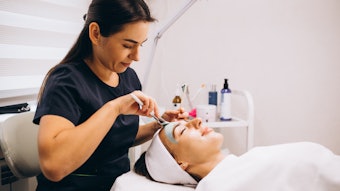
Do you know your retail to service/procedure ratio? Are your retail sales accounting for 20% of your overall monthly revenue? If you answered no to either of those questions, you are not alone! That’s why I wanted to take this opportunity to explain how incorporating retail products into your practice can substantially strengthen your sales program, increase patient satisfaction, boost profitability and increase patient retention. All things vital to patient outcomes and a healthy practice. Here are the key aspects of a successful retail program and how it can benefit your practice, as well as how you can build one for your medspa or aesthetic practice in seven essential steps.
Key Aspects of a Successful Retail Program
The key to a successful retail program is to focus on products that compliment your treatments/services and procedures. Don’t try to be a one-stop-shop. Carefully define what products will augment your offerings, research the options, have the reps come in and perform an in-service and ask to evaluate the products in addition to understanding the numbers and the support the company offers.
Once you’ve selected your vendors and the lines you want to carry (my recommendation is no more than three to four SKU's) then spend the time and resources necessary to train your staff and integrate the products into your personalized treatment plans. After you’ve launched your retail program, follow up on the numbers and adjust as necessary to fine tune and maximize profitability.
My motto is, “Always be educating.” If you’re not, or your team is not, statistics show your patients will go to a department store or CVS and buy products, which obviously do not add value or translate to the best outcomes.
7 Steps to Building a Retail Program
1. Define Your Niche
The most important step in building a successful retail program is defining your niche with the products you offer. The products you choose should be carefully tailored to your long-term treatment plans (more on this in a bit). Don’t try to offer every product on the market. This will overwhelm your patients and will negatively impact your retail profitability. Why? Because patients will feel less like they are being offered a product to enhance their specialized treatment/procedure, and more like they are being sold as many products as possible to increase their overall expenses. When you focus on a specific retail line, you give patients the impression that you have carefully selected a product that will complement their services/procedure, leading to increased patient satisfaction and trust. By focusing on a particular product line, you also give your staff the opportunity to really learn the products, applications and relevant technology. Their ability to answer patient questions accurately and thoughtfully is critical and will further enhance the patient experience.
2. Research the Options
Conduct careful and thorough research of potential retail partners, their products and their current relationships with other offices. Once you’ve decided on a specific type of product, take note of how many retailers offer that product and what types of products are typically offered in parallel. When choosing a vendor, prioritize product quality and partnership satisfaction. Product quality is crucial. What you offer patients in your office will reflect on the overall quality of your services, and your goal is to offer the best patient experience possible. Equally as important is partnership satisfaction. How easy is the vendor to work with? How frequently are they willing to deliver and replenish inventory? What are the potential mark-ups on each product? Is there any opportunity to grow with the vendor and expand as demand increases? What educational support do they offer? Are there minimum quantities? Do they buy back? These are key details to know in advance of making any binding commitments with potential vendors. The vendor you choose should have a strong record of sales, customer reviews and partner relationships.
3. Evaluate the Numbers
Once you’ve identified a few vendors, you’ll want to dig deeper into the numbers. What types of products offer the highest profitability in the medical aesthetics office market? What products offer patients the best outcomes both in combination and stand alone. What are the profit margins for some of the key products in each retail line you’ve targeted? What is a typical quarterly ROI? While some of these numbers are relatively straightforward to calculate, others may be more difficult to pinpoint and will require careful research. A key part of your investigation should be based on patient satisfaction. After all, even if profitability on a product is historically high, you must first sell the product to make a profit.
Research how well customers respond to specific products offered by each vendor and calculate an estimate of overall satisfaction. It may also be beneficial to reach out to other medical aesthetics offices that offer specific products and request a rough estimate of patient satisfaction. What percentage of patients who buy this product review it positively? Would they recommend it to a friend or colleague? How many times have they purchased the product over the last year? How many products does a patient purchase on average? Some of these numbers may be provided by the vendor themselves, particularly if they are a more established entity. Though careful research takes time, it will be worth your investment to evaluate potential vendors by the numbers before making a commitment.
4. Manage Your Relationship with Vendors
Once you’ve identified the vendors you want to work with, your next step is to establish and maintain a healthy relationship with this business partner. First, make sure any contractual agreements signed are mutually beneficial. In most cases they will be because you have parallel goals—to satisfy patients and sell products. Because product prices can fluctuate with the market, you may want to request written confirmation that the price will not fluctuate more than a maximum allowable percentage, based on your evaluation of profitability. The most important part of managing your relationship with vendors is to maintain transparency. Pass along feedback on their products from your patients, whether it be positive or negative. They may be able to expand a specific line or improve upon existing products to better satisfy patients in your office. The goal is to grow together. If your sales program is performing exceedingly well, they will be able to learn from you. If your sales have become stagnant, they may be able to offer tips on how to boost your marketing program and may even provide literature or product demonstrations to increase your success with the product. Seek to establish and maintain a positive, honest and mutually beneficial relationship with your vendor.
5. Integrate Products Into Your Treatment Plans
Aside from product quality and vendor relations, the most important part of a successful retail program is how well you integrate product lines into your treatment plans and services. The products you have chosen to sell should not stand alone in the back corner of your waiting area. Spotlight the products by featuring them in personalized treatment plans and monthly specials.
Did you know the amount spent on skin care is three times more than that spent on services or procedures? Every procedure should have a product and additional procedures to augment. With this revenue strategy, retail should be 20% of your total revenue.
- Example A: Clear & Brilliant ($500) + Retinal & Antioxidant ($200) and post-op Hydrafacial, $250 = $950
-90% increase in revenue
- Example B: Micro Needling Treatment ($450) + Serum and Accelerator ($280) = post-op Hydrafacial ($250) = $980
-118% increase in revenue
- Example C: Full Facelift ($20,000) + Laser Resurfacing pre-op ($1,500) + Retinol and Antioxidant ($200) and post-op Vascular laser ($75) and Hydrafacial ($250) = $22,025
-More than 10% Increase in revenue
When patients have their skin care built into their treatment plan, they will:
- Use the best products for their skin that you know will yield the best possible outcomes.
- Be more likely to practice home care compliance.
- Experience increased convenience as they can purchase them at the same time as they book their treatment/procedure or follow up appointments.
- Be excited to experience something new.
When providers build skin care and or other treatment modalities into their treatment plan or pre-op and post-op care, they will experience these benefits:
- Volume. Comprehensive treatment packages increase sales.
- Margins. Comprehensive treatment packages can lower the cost of goods sold and increase your profit margins.
- Exposure. Comprehensive treatment packages offer new opportunities and exposure to additional treatments.
According to a recent survey by the New York Post, the average female consumer spends $313 per month on products for her face and men spend $244. The survey states that 82% of men are now using skin care. If even 20 patients spent that on products you recommend versus buying over-the-counter products, that would be an extra $6,260 per month of revenue generated by women and $4,880 for men.
Let’s take a little deeper dive into patient expectations versus reality.
- 86% of patients expect physicians to recommend a pre-treatment skin care regimen, yet only 14% of patients were recommended at-home care.
- 91% of patients expect physicians to recommend a post-care skin care regimen, yet only 30% of patients were prescribed post-care products.
So, you can see the clear gaps in the industry and how comprehensive treatment plans can increase your revenue opportunities and create better results for your patients.
6. Train Your Staff
The success of your retail program is directly proportional to how well your staff is trained. It is critical that every member of your staff listens to and engages your patient population. They should be intimately familiar with the personalized treatment plans and services you offer. When you launch a retail program, invest in staff training. A well-trained staff will have a thorough understanding of your products, how they will be incorporated into your treatment plans and how they compare to similar products on the market. The goal is to inform your staff so they can inform your patients. When a patient asks about a specific product, they should receive a well-informed, positive response. Not only will this help to increase trust in your staff, but it will also boost sales and lead to increased profitability.
7. Keep an Eye on the Numbers
Once you’ve built a retail program, you’ll want to review the numbers at least once a quarter. Calculate your overall ROI on retail sales and determine which products have the highest sales and profitability rates. Also take note of which products patients purchase more than once. The most expensive products do not always offer the highest profit margins. Use this data to tailor your marketing program and staff training, if needed.












